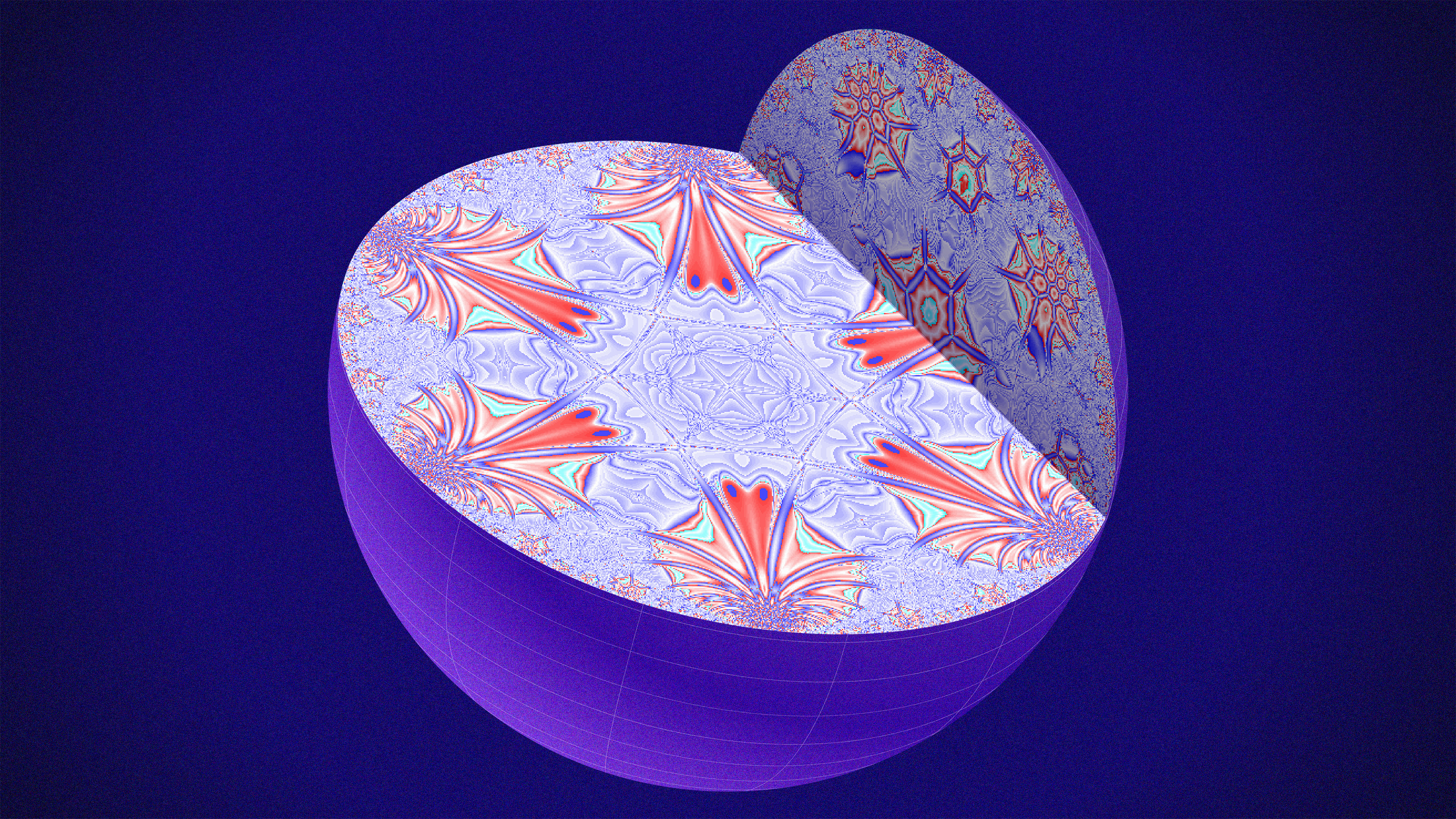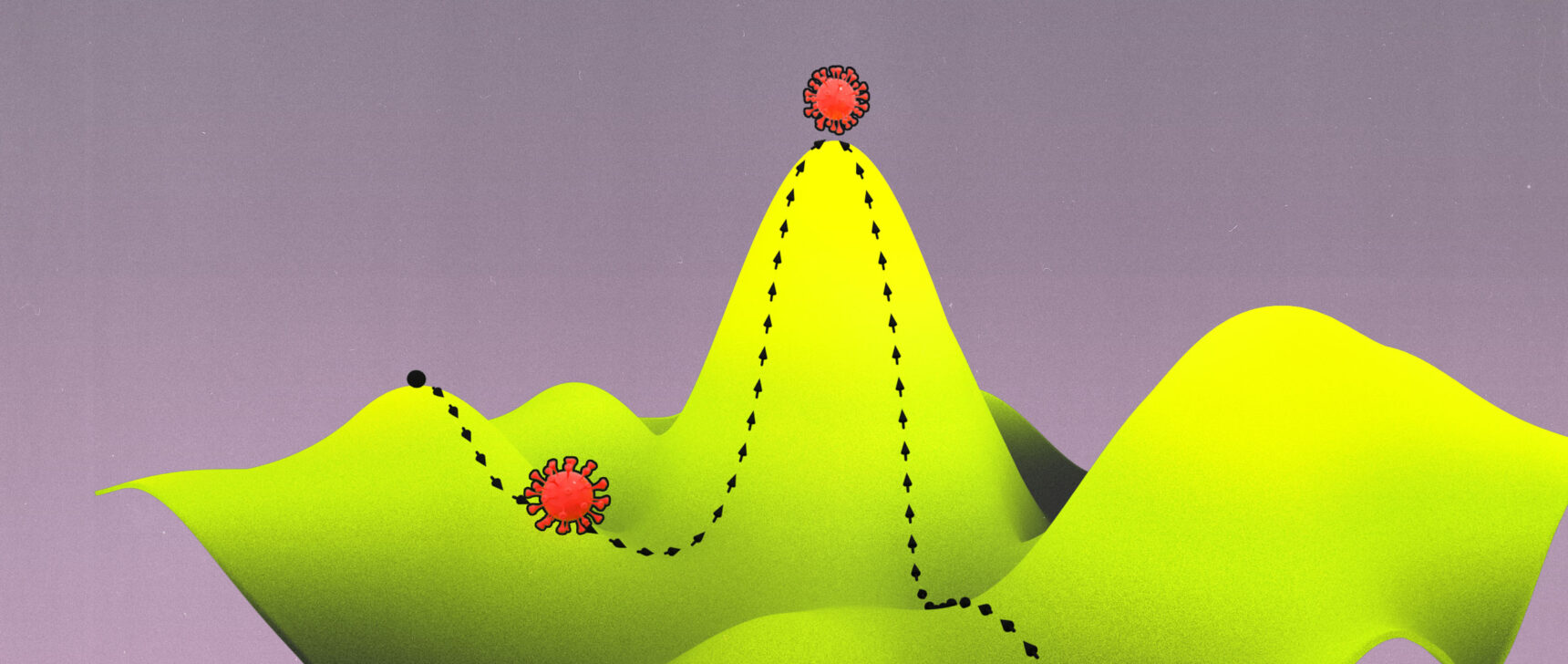Symmetries Reveal Clues About the Holographic Universe

Researchers have long studied how gravity might emerge from a two-dimensional surface in hyperbolic spaces such as this one. In our own universe, the surface would be infinitely far away.
Kwok Wai Chung
Introduction
We’ve known about gravity since Newton’s apocryphal encounter with the apple, but we’re still struggling to make sense of it. While the other three forces of nature are all due to the activity of quantum fields, our best theory of gravity describes it as bent space-time. For decades, physicists have tried to use quantum field theories to describe gravity, but those efforts are incomplete at best.
One of the most promising of those efforts treats gravity as something like a hologram — a three-dimensional effect that pops out of a flat, two-dimensional surface. Currently, the only concrete example of such a theory is the AdS/CFT correspondence, in which a particular type of quantum field theory, called a conformal field theory (CFT), gives rise to gravity in so-called anti-de Sitter (AdS) space. In the bizarre curves of AdS space, a finite boundary can encapsulate an infinite world. Juan Maldacena, the theory’s discoverer, has called it a “universe in a bottle.”
But our universe isn’t a bottle. Our universe is (largely) flat. Any bottle that would contain our flat universe would have to be infinitely far away in space and time. Physicists call this cosmic capsule the “celestial sphere.”
Physicists want to determine the rules for a CFT that can give rise to gravity in a world without the curves of AdS space. They’re looking for a CFT for flat space — a celestial CFT.
The celestial CFT would be even more ambitious than the corresponding theory in AdS/CFT. Since it lives on a sphere of infinite radius, concepts of space and time break down. As a consequence, the CFT wouldn’t depend on space and time; instead, it could explain how space and time come to be.
Recent research results have given physicists hope that they’re on the right track. These results use fundamental symmetries to constrain what this CFT might look like. Researchers have discovered a surprising set of mathematical relationships between these symmetries — relationships that have appeared before in certain string theories, leading some to wonder if the connection is more than coincidence.
“There’s a very large, amazing animal out here,” said Nima Arkani-Hamed, a theoretical physicist at the Institute for Advanced Study in Princeton, New Jersey. “The thing we’re going to find is going to be pretty mind-blowing, hopefully.”
Symmetries on the Sphere
Perhaps the primary way that physicists probe the fundamental forces of nature is by blasting particles together to see what happens. The technical term for this is “scattering.” At facilities such as the Large Hadron Collider, particles fly in from distant points, interact, then fly out to the detectors in whatever transformed state has been dictated by quantum forces.
If the interaction is governed by any of the three forces other than gravity, physicists can in principle calculate the results of these scattering problems using quantum field theory. But what many physicists really want to learn about is gravity.
Luckily, Steven Weinberg showed in the 1960s that certain quantum gravitational scattering problems — ones that involve low-energy gravitons — can be calculated. In this low-energy limit, “we’ve nailed the behavior,” said Monica Pate of Harvard University. “Quantum gravity reproduces the predictions of general relativity.” Celestial holographers like Pate and Sabrina Pasterski of Princeton University are using these low-energy scattering problems as the starting point to determine some of the rules the hypothetical celestial CFT must obey.
They do this by looking for symmetries. In a scattering problem, physicists calculate the products of scattering — the “scattering amplitudes” — and what they should look like when they hit the detectors. After calculating these amplitudes, researchers look for patterns the particles make on the detector, which correspond to rules or symmetries the scattering process must obey. The symmetries demand that if you apply certain transformations to the detector, the outcome of a scattering event should remain unchanged.
Just as quantum interactions can be translated into scattering amplitudes that then lead to symmetries, researchers working on quantum gravity hope to translate scattering problems into symmetries on the celestial sphere, then use these symmetries to fill out the celestial CFT rulebook.
“We’re trying to just start from the basic ingredients of the dictionary,” said Pasterski, referring to the symmetries, “and then move up from there.”
In November, a group led by Andrew Strominger of Harvard University published a paper that describes the “symmetry algebra” the celestial CFT must obey. The algebra dictates how different symmetry transformations combine to form new transformations. By studying the structure of the composition of the transformations, Strominger and his colleagues, including Pate, have managed to further constrain the potential CFT. They discovered that the group of symmetries on the celestial sphere obeyed a thoroughly studied and well-established algebra — one that has already appeared in certain string theories and is related to the description of well-known quantum systems such as the quantum Hall effect.
“The fact that the structure you landed on is something that people have explored and played with before gives you encouragement that maybe there’s something to it,” said David Skinner, a theoretical physicist at the University of Cambridge.
Infinite Issues
When you have a theory that applies to an infinitely distant sphere, problems arise. Consider two particles that come together and scatter apart. If they scatter apart at any nonzero angle, by the time they reach the infinitely distant celestial sphere, they will also be infinitely far apart. The notion of distance breaks down. Our normal theories rely on locality, in which the strength of interactions between objects depends on their distance from one another. But if everything is infinitely far from everything else, the CFT must transcend locality.
Even more perplexing: What is the concept of time on the celestial sphere, which is infinitely far in both the past and in the future? It has no meaning here.
Arkani-Hamed considers the fact that concepts of space and time break down on the celestial sphere to be a feature, not a bug. It offers the potential to explain space-time as an emergent property of a more fundamental theory.
Others temper their enthusiasm. “I think it’s exciting, but I think there’s a long way to go,” said Skinner. “There are some things that I would say are major challenges to overcome.”
Arkani-Hamed doesn’t disagree. “The whole thing is sort of grasping and figuring out what the question is. But the stakes are also similarly high.”



